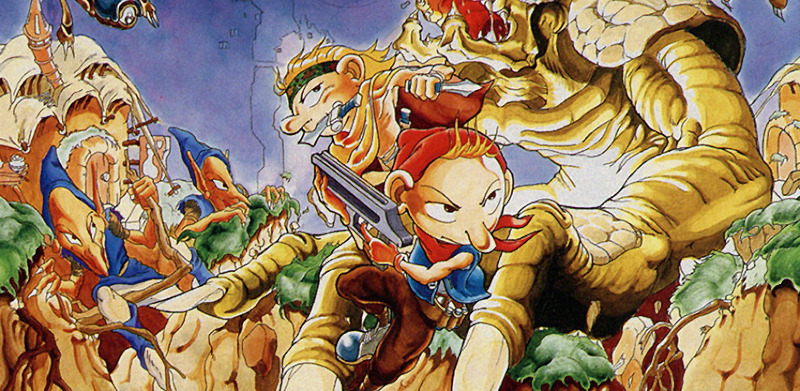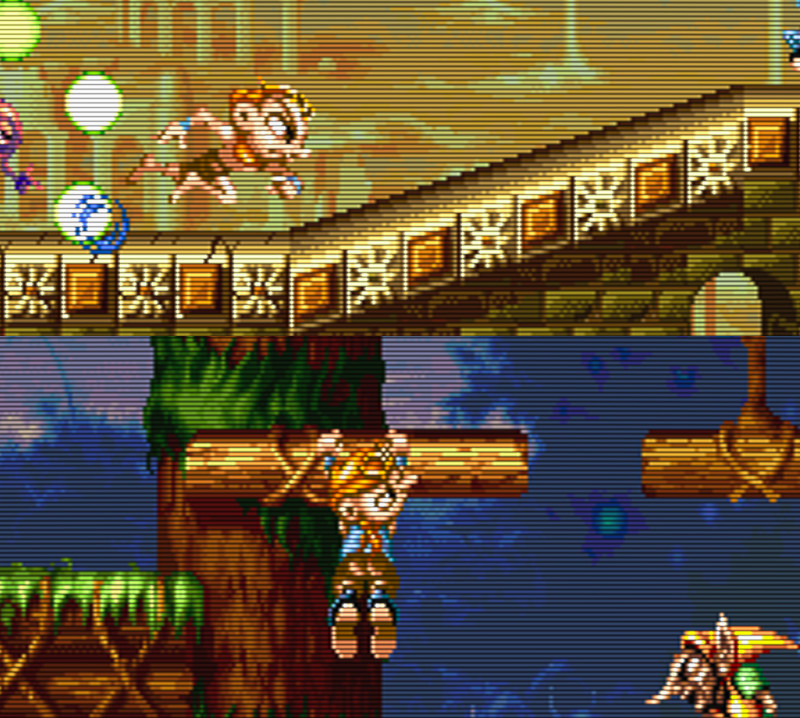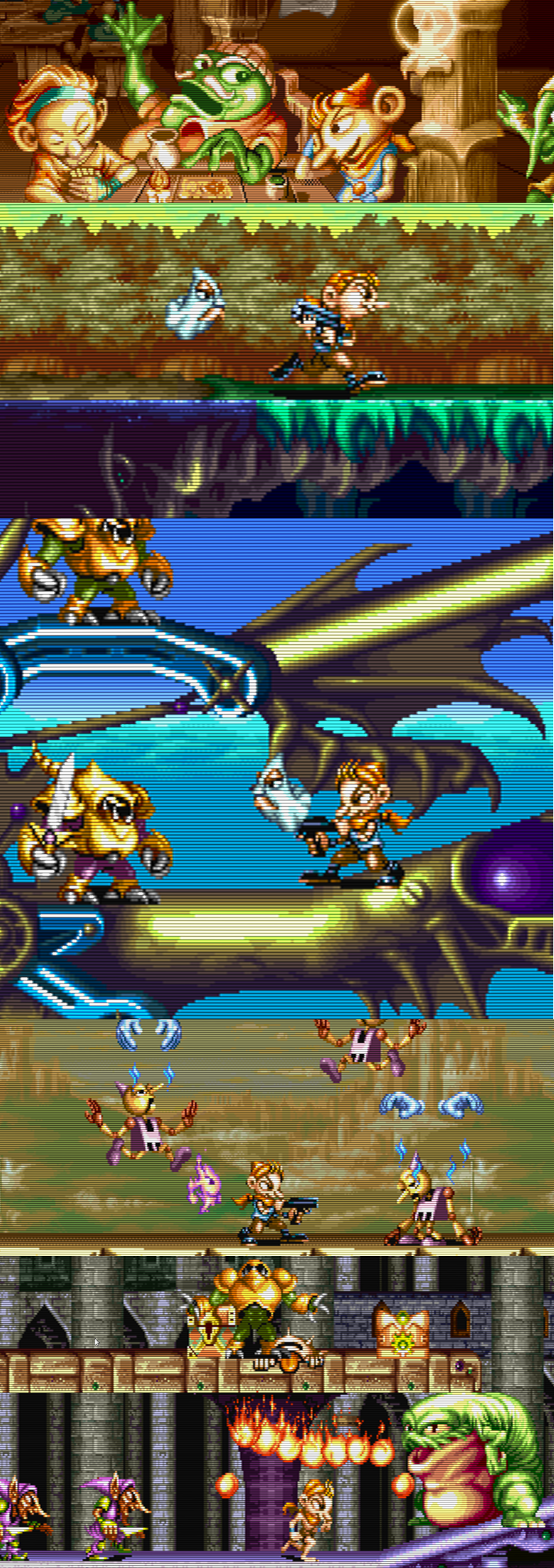 Wonder 3: Roosters / Three Wonders: Midnight Wanderers (1991, Capcom)
Wonder 3: Roosters / Three Wonders: Midnight Wanderers (1991, Capcom)
Despite being released as part of a three game compilation, Roosters is a high quality product that outclasses many standalone titles. In terms of story it is effectively part 1, sharing ROM space with its sequel, the horizontal STG Chariot. The idea of two thematically related games with distinct genres being packaged together is an interesting one, Chariot being quite solid in its own right. The unrelated, decent but not terribly remarkable overhead block puzzle game Don't Pull tags along, a likely afterthought to sweeten the pot even more for arcade operators. Befitting of its ability to stand out on its own strength, though, our discussion will focus only on Roosters, known as Midnight Wanderers in the west.
Roosters is Daimakaimura-Lite. The size of the sprites and playfield are similar, the level design revolves primarily around endlessly spawning enemies coming from both sides, taking one hit makes you lose your clothes and the second hit kills you, your firing rate and projectile speed are about the same, there are a variety of weapons available, you get items from chests, and so on. I wouldn't be surprised if they shared a substantial amount of code. The -Lite appellation refers not to a lack of features but to its lighter difficulty from the added degree of control. Firstly, it uses an 8-way joystick instead of a 4-way which allows for changing direction while crouching, and for a new quick dash move similar to the slide move in Capcom's earlier Strider, by holding down+left or down+right and pressing the jump button. You can also hang from the bottoms of platforms and move along them while hanging. Another important difference is that you can affect the trajectory of your jump in mid-air, which significantly decreases the level of commitment and thought required when platforming.

And it all feels pretty good. Your jump height is adequate for the level designs, and while the walk speed could be a touch faster, the compulsive joy of dashing continuously in between bursts of combat compensates for it well enough. Unloading shots into enemies and bosses is fairly satisfying, though your sturdier targets sometimes lack a little bit of reactive energy, in that they'll only flash a couple of times upon getting hit before actually having any kind of damage animation, but it's only a very slight detriment to the feel of those engagements. Overall, in terms of mobility and feel, Roosters has the leg-up on its older cousin.
In addition to feeling mechanically tight, Roosters is a very attractive game. It has a great fantasy cartoon aesthetic, all very well drawn and competently animated. In action all the sprites are nice and big and detailed and the backgrounds are gorgeous, and the brief cutscenes, while sometimes consisting of only in-game sprites and backgrounds, do occasionally have some absolutely delightful portraits and facades. Your journey will take you through several environments with distinct scenery, and for the first half of the game mostly distinct enemies. The palette swaps and boss rushes start to pile on in the second half, but the look of the rest of your surroundings stays fresh and grows darker and more sinister throughout. The music, on the other hand, is almost purely facilitative. It gives the right fantasy notes to compliment the theme, but aside perhaps from stage 2, no track really stands out.
Stage 2 music

There are 3 different weapon types and, interestingly, 3 different option types distributed throughout the stages. The option floats over your shoulder to provide additional firepower of a kind separate from your main shot, a mechanic you don't normally see in a run and gun. So you start off with a plain arrow that fires straight ahead; it doesn't do much damage but it has the best fire rate out of all the weapons. Of the additional weapons you can find you have the Hyper Shot that consists of a knife flying forward and a kind of boomerang-looking thing that falls in an arc with it, the Tail Shot that sends a spinning blade forward and then backward behind you if it doesn't hit anything, and then the Bound Shot which surrounds your arrows with blue energy that turns a into laser and ricochets off of whatever the arrow hits. In the options department you get one that fires flames forward in a kind of canoe shape, one that shoots balls of energy that home in on available targets, and one that fires a line of swirling energy along the floor.
Bound Shot is insanely slow and its ricochet properties completely useless, and therefore best avoided completely. Tail Shot isn't a total loss considering you do quite often have enemies on your back, but the fast, powerful Hyper Shot is simply good enough in any given situation, and the Hyper+Flame loadout will get you through the entire game without any need to deviate. Thus we have yet another example of a pitfall of many arcade games, in that despite there being a variety of weapons to find and choose from, there's one vastly superior setup that will get you through whatever the game throws at you. There may be small areas in which, say, Tail Shot is better than Hyper Shot, or the Homing Option is better than the Flame Option, but when these weapons and options are randomly dealt out in chests it's not worth switching for that one part when there's a good chance you'll end up stuck with it in areas where they're subpar.

The level design is mostly solid if a bit unimaginative. The primary issue is a noticeable lack of verticality; you get a cool little slide section in the first stage and a couple of ladder climbing sections later, but nothing like stage 3 of Daimakaimura's long autoscrolling ascent, or stage 4's waterfall descent leading to the heart-stopping dive into the huge chasm filled with plant monsters. And this is to say nothing of Strider with its constant running, jumping and climbing in all directions, a game 2 years older no less. You're pretty much running left to right here. The missing originality is well enough softened by the great art; at the very least, it's always nice to look at. The level design in the mechanical sense, much like the music, is adequate. It checks a box and doesn't get in the way.
The pace can plod a bit too, where in later stages both sides of the screen can get clogged with enemies and you get stuck just jumping and firing for a while before being able to move forward. The length of this one round game is about equal to if not longer than Daimakaimura's two rounds, but it's hard to say that it has more content. It feels more like the slow-ish walk speed and stop-start nature of later parts of the game are what lengthen it. The bosses can be at fault here too, in that they take kind of a long time to destroy while not being particularly challenging or engaging.
The difficulty curve is just about perfect. It ascends steadily with only small, readily surmountable spikes. The challenge actually errs more towards the side of easy, but you start with 2 lives rather than the standard 3, which balances it out nicely. Getting extends relies on collecting cards, valued randomly from 1 point to 5 points, and you get these cards from chests and from defeating bosses and certain enemies. Getting 100 points awards the extra life. You get quite a few extends throughout the course of the game, all in all making for a breezy one credit clear but a reasonably difficult no-miss. Scoring, consequently, is devalued even as an extend mechanism, and it consisting solely of the standard Kill Enemies and Collect Items routine leaves only tedious milking of respawning enemies for the most dedicated of score chasing maniacs.
In the realm of arcade gaming, Roosters is workmanlike in the best of ways. Graphically it excels masterfully and the controls are tight and responsive, while it achieves basic competence in all other respects. It offers a softer, more vibrant alternative to Daimakaimura's punishing difficulty and stiff controls, but sacrifices a bit in the audio and level design departments. It feels like a product made by the best of the best arcade game developers just needing to put something out. There's an effortlessness to it. One can imagine that if Capcom had bet on releasing this as a standalone title, maybe that special touch evident in some of their previous stellar sidescrolling action games would have graced this one as well.
Final Rating: 4/5 (Good)